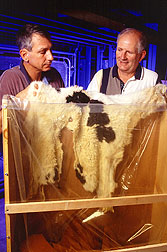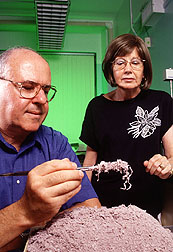Tanning Research Update
|
|
The process that turns raw cowhide into supple leather is a complex one. But scientists at the Eastern Regional Research Center (ERRC) in Wyndmoor, Pennsylvania, have come up with innovative ideas to increase the efficiency of processing those animal skins into leather, while ensuring better quality end products.
"Not only does our research benefit the hide-tanning industry, it also promotes the health of the environment," says William N. Marmer. He heads the ERRC's Hides, Lipids, and Wool Research Unit, a part of USDA's Agricultural Research Service.
"We have our own pilot plant tannery here at ERRC," Marmer says. "This is the only public facility of its kind in the United States. Domestic tanners come here to take short courses sponsored by the U.S. leather industry."
According to Marmer, cattle hides are the most valuable coproduct of the meat packing industry.
"Here in the United States, we produce about 35 million of them each year," he says. " About 60 percent are exported as preserved hides that's more than $1 billion in foreign trade. The remainder are tanned into about $4 billion worth of finished leather here in the United States."
Preserving Hides for Later Tanning
Throughout history, sodium chloride (NaCl), or common salt, has been the key to preserving hides and foods like fish and meat, primarily because it draws water out of products. Early trappers favored salt to cure meat and hides because it's easy. Bacteria which can destroy a hide's quality can't grow in the absence of water.
Salt is still used to preserve hides that can't be immediately tanned. But this salt curing puts a load on the environment.
"Each salt-cured hide produces a gallon of salt-saturated brine that must be disposed of," says biochemist David G. Bailey. "If a packinghouse cures 5,000 hides a day, it'll have to dispose of 5,000 gallons of salt water. Tanneries must then wash out that salt before converting the hides to leather. But adding salt water to soil lowers fertility and leeches important minerals like magnesium, iron, and manganese deeper into the earth, away from plant roots."
Bailey's research has identified three solutions to the brine problem: potassium chloride, electron beam irradiation, and gamma irradiation.
"We've shown that each of these is an effective, viable alternative to curing hides with common salt," Bailey says. "They're just not being used by the tanning industry simply because salt is cheap and easy to use, and there is no mandate that prohibits its use."
Using potassium chloride (KCl), or potash, to cure hides would actually be beneficial to the environment because potassium is a plant nutrient that enhances growth. However, potash is a little more expensive than NaCl, adding about $2 to the cost of curing each hide.
"We found no major differences in the quality of 2,500 hides tanned with KCl compared to hides tanned with NaCl," Bailey says. "And while there are minor differences in the process, there are no technical obstacles."
ARS scientists have a formal research agreement with Kalium of Canada, Ltd, and informal collaboration with other hide processors and tanners.
Irradiation Also Works
Curing with electron beam irradiation differs from gamma irradiation simply in the source of the energy. The electrons kill bacteria that would otherwise destroy hides, and sterile packaging then prevents reinfection. Research shows that irradiation in the presence of small amounts of bactericide prolongs the shelflife of treated hides sufficiently for long-distance shipping to a tannery and eliminates the need for sterile packaging.
In electron beam irradiation, cathode ray tubes similar to those in a television set zap hides with energy beams of 3 to 10 million volts. Gamma rays, on the other hand, are produced by a cobalt source contained at the bottom of a 20-foot-deep pool of water.
According to Bailey, both treatments protect the hides effectively. Gamma irradiation disperses electrons more uniformly throughout the hide, but electron beams treat a more uniform thickness.
Cost-wise, gamma irradiation is more economical for very large numbers of hides, while the electron beam approach favors smaller operations. Gamma irradiation takes hours; electron beam, seconds.
"Garden State Tanning in Williamsport, Maryland, is evaluating leather made from hides preserved with both these processes," Bailey says. "Both irradiation methods are already being used throughout the world on a wide variety of products including bandages and other soft medical supplies. They're also used to alter the physical properties of some plastic."
In addition to disposing of waste, another problem with using NaCl to cure hides is that the salt promotes the growth of halophilic bacteria. These salt-loving bacteria have been associated with "bad" hides because they cause a red pigmentation, called red heat, on the hide.
Industry has always thought that a hide with red heat must be tanned as soon as possible because there is potential for hide damage by these bacteria. Bailey and colleagues have shown that at the point where red heat becomes visible, hide damage has already occurred.
Turning Waste Into High-Value Products
From 100 pounds of cattle hides, a tanner gets only 50 pounds of leather and 50 pounds of waste.
"One of the chemicals used in the tanning process is chromium-III sulfate, which is nontoxic," says Marmer. "Therefore, most leather contains chromium. When tanners shave the bottom sides of chromium-tanned hides to give them a uniform thickness, so-called chrome shavings end up as waste that must be hauled to landfills at a price. The tanning industry generates more than 60,000 metric tons of chrome shavings each year," he says.
Marmer and chemists Maryann M. Taylor and Eleanor M. Brown have found a way to make two types of protein from this waste and to recycle the residual chrome back into the tanning process.
"We used a common laundry detergent enzyme called alkaline protease to break down the chrome shavings," Taylor explains. "Our initial product was a low-value gelatin protein that can be used in fertilizer and animal feed.
"Our second-generation product was a higher value protein, a technical grade of gelatin that can be used in making adhesives, industrial films for packaging, and encapsulating agents for industrial and agricultural chemicals. We found that our gelatin has functional properties equal and in some cases, superior to commercially produced gelatins."
Taylor chemically purified the chromium left over after the proteins were removed and reused it as an agent in the tanning process. "We got leather of quality comparable to that tanned commercially," she says. Taylor has even found a way to recycle the enzyme used to liberate the proteins.
ARS holds two patents on the process to convert the waste to protein products. Scientists at Spain's CSIC/CID national research laboratory and at Ramon Llull University in Barcelona collaborated on part of the research. ARS also has a cooperative agreement with ATO-DLO, a Dutch institution, to develop applications for the protein products.
Marmer would like to see the chrome recycling process implemented at U.S. tanneries.
"The process, modified for use in the Czech Republic by the Technical University of Brno at Zlin, is now being used at a Czech tannery," Marmer says. "We've determined through cost analyses that the process is economically feasible. "By Doris Stanley, Agricultural Research Service Information Staff.
Scientists mentioned in this article are located at the USDA-ARS Hides, Lipids, and Wool Research Unit, Eastern Regional Research Center, 600 East Mermaid Lane, Wyndmoor, PA 19038-8551.
[William N. Marmer] phone (215)-233-6585, fax (215) 233-6795.
[David G. Bailey] phone (215)-233-6486, fax (215) 233-6795.
[Maryann M. Taylor] phone (215) 233-6435, fax, (215) 233-6795.
[Eleanor M. Brown] phone (215) 233-6481, fax (215) 233-6795.
"Tanning Research Update " was published in the November 1998 issue of Agricultural Research magazine. Click here to see this issue's table of contents.








